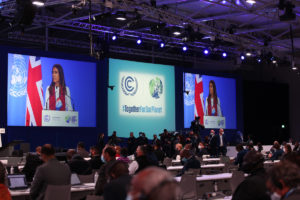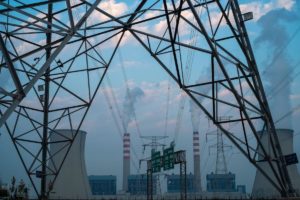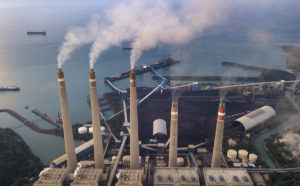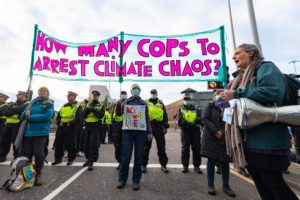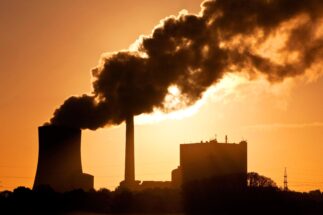“The Earth is speaking. She tells us that we have no more time.” This assessment by Txai Suruí, a Brazilian indigenous activist at the opening of the COP26 climate talks could not have been more sombre. Coming directly after the G20 summit of the previous weekend that saw limited progress on climate issues, the UN talks in Glasgow did not start on a strong footing.
Though leaders of 20 of the largest economies committed to end the public financing of overseas coal-fired power by the end of this year, they stopped short of making the same commitment within their own borders. They also confirmed ongoing commitment to the 1.5C warming limit of the Paris Agreement, but without promising to revise their national climate plans to be in line with this goal.
Lead negotiator for the Alliance of Small Island States (AOSIS) negotiating bloc, Lia Nicholson, used her opening statement to throw down the gauntlet to heads of state as the COP26 world leaders’ summit got under way.
“Governments must be called to account and explain to the world and their own people what could be more urgent than this crisis and the failure to act,” she said. The urgency of the situation was summed up in a statement from AOSIS that COP26 might be the “last stand” to keep the 1.5C goal alive.
Halting deforestation
Still, there was no shortage of new pledges and initiative launches as the summit got under way. The first major news was a commitment to halt forest loss and land degradation by 2030 signed by over 130 global leaders – including those from Indonesia, Russia and Brazil.
The pledge, The Glasgow Leaders’ Declaration on Forests and Land Use, is backed by US$12 billion public and $7.2 billion private funding, while heads of more than 30 financial institutions with over $8.7 trillion of global assets, including Aviva, Schroders and Axa, also committed to eliminate investment in activities linked to deforestation.
The initiative covers 90% of the world’s forests, an area of over 3.6 billion hectares that absorbs around one third of global CO2 released from burning fossil fuels each year. It effectively replaces the New York Declaration on Forests made in 2014, which was signed by only 37 governments and has been judged a failure by an independent assessment published in October.
However, the initiative suffered an early blow when Indonesia’s Minister of Environment and Forestry, Siti Nurbaya Bakar, declared on social media that “forcing Indonesia to zero deforestation in 2030 is clearly inappropriate and unfair”.
“Indonesia’s natural wealth, including forests, must be managed for its use according to sustainable principles, besides being fair, of course,” she wrote.
Rapid action on methane
On energy, the US led a move to cut methane emissions by 30% by 2030. Originally launched at the UN General Assembly in September with just eight countries and the EU as signatories, the methane pledge has now been signed by more than 100 countries, covering almost half of global production of the gas.
Methane has more than 80 times the climate-warming potential of carbon dioxide in the first two decades after it enters the atmosphere but breaks down far more quickly. This means that reducing emissions now will have a big impact in the near term, according to the UN Environment Programme.
Climate finance
Finance remains a sticking point, particularly the $100 billion per year owed by rich countries to poor ones for climate mitigation and adaptation. Though this had originally been promised by developed countries to poorer nations in 2009, only $79.6 billion was delivered in 2019, according to the latest assessment. This has led to a lack of trust from developing countries in the talks.
The governments of Germany and Canada teamed up to encourage additional climate finance pledges prior to the start of COP26. Based on pledges made as of 20 October 2021, “significant progress” towards the $100 billion will be made by 2022, and should be met in full by 2023, according to a delivery plan published by the two governments. They also expect that more than $100 billion will be mobilised each year from then on.
Away from the COP conference, the US Special Presidential Envoy for Climate, John Kerry, declared at a side event that richer nations are on track to provide the targeted $100 billion by next year. While delivered more as a personal assessment than a pledge, Kerry said this would “take that issue off the table” and change the dynamics of climate action.
Efforts have also been underway to mobilise private sector cash for climate action. Mid-week, former Bank of England governor Mark Carney announced $130 trillion of private finance through the Glasgow Financial Alliance for Net Zero (GFANZ), which will focus on supporting developing countries and emerging markets to meet net zero targets by 2050.
Members of the alliance, which comprises more than 450 banks, insurers and asset managers across 45 countries, must set robust, science-based near-term targets within 12 to 18 months of joining. However, GFANZ has been slammed as greenwash by climate campaigners as it allows financial groups to continue supporting fossil fuel companies in the near term.
Leaving fossil fuels behind
Separately, South Africa will be provided with $8.5 billion over the next three to five years to support its transition to clean energy. The financing to the country, the world’s most carbon-intensive electricity producer, is part of a move by more than 35 world leaders who signed up to scale and speed the development and deployment of clean technologies and drive down costs this decade.
Signatories include the US, India, the EU, Kenya and Nigeria – collectively representing more than 50% of the world’s economy and every region. The aim is to make clean technologies the most affordable, accessible and attractive choice in the most polluting sectors by 2030, focusing on power, road transport, hydrogen, steel and agriculture, which together represent more than half of total global emissions.
On energy, moves towards ending overseas financing for fossil fuels stole the headlines. A trend towards abandoning support for coal is expanding to oil and gas, with more than 25 countries and finance institutions, including the US, Canada and the European Investment Bank – some of the largest historical providers of public finance for fossil fuels – signing a plan to redirect cash to clean technologies.
This is the first international political commitment that also addresses public finance for oil and gas. If implemented effectively, it could directly shift more than $15 billion a year out of fossil fuels and into clean energy, according to campaigners at Global Justice Now.
However, Japan, South Korea and China – the largest providers of international public fossil fuel finance in the G20, which together account for 46% of G20 and multilateral development bank finance for fossil fuels – have not yet supported the initiative.
It’s very positive that countries are aiming for net zero, but many haven’t yet put forward credible plans to get thereTaryn Fransen, World Resources Institute
On coal alone, 46 countries, alongside 32 businesses and other organisations, signed up to phase out existing power stations, and not plan any new ones. The initiative is significant because several major coal-burning economies signed the declaration, specifically Vietnam, Indonesia, South Korea, Poland and Ukraine. It covers over 267GW of operating coal capacity, cumulatively more than the US (232.8GW) or India (233.1GW). However, the US, India and China are missing from the pact.
Announcements of more ambitious climate action by various countries during the first week of COP26 – including India’s commitment to net zero emissions by 2070, and the generation of 50% of its energy from renewable sources – have led to more positive assessments of the chance of meeting the Paris Agreement goal of keeping global average temperature rises to within 1.5C above pre-industrial levels.
The International Energy Agency has predicted that the range of plans – if implemented in full and on time – would leave the world on track for a 1.8C temperature rise by 2100, rather than 2.1C as was the case before the talks began.
Taryn Fransen, senior fellow in the global climate programme at US think tank the World Resources Institute, said that most of the improvements in these analyses had come from new announcements of net-zero targets by countries, rather than actual plans and policies set out in national emissions reduction targets, known as nationally determined contributions (NDCs).
“It’s very positive that countries are aiming for net zero, but many such as Turkey, Australia, Saudi Arabia and Russia haven’t yet put forward credible plans to get there, and their 2030 targets don’t suggest the near-term transformative action that is needed,” she said.



